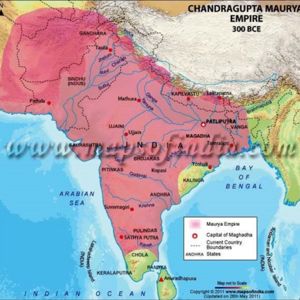Talk:Chandragupta Maurya (ruled from 322–298 BCE) & Guru Cāṇakya
By Vishal Agarwal
In 327 BCE, Alexander invaded the northwestern regions of India after his victory over the Persian Empire. Among the first Indian rulers he encountered was King Āmbhi of Takṣaśilā (modern-day Taxila, Pakistan), who surrendered without resistance. At that time, Takṣaśilā was a renowned centre of learning, housing a great university where Chāṇakya was one of the eminent teachers.
Alexander advanced through Takṣaśilā with ease until he met King Paurava (identified with Porus in Greek accounts), who ruled the region of western Punjab. Although Alexander’s forces greatly outnumbered those of Paurava, the ensuing battle was won by the Macedonian army only with considerable difficulty.
After this encounter, Alexander planned to proceed eastward to conquer northern India, which was under the rule of the powerful Nanda dynasty. However, his troops—exhausted by continuous campaigns and fearful of the Nanda strength—refused to advance further. Homesickness and fatigue eventually compelled Alexander to abandon the campaign. He left the territories of present-day Pakistan and Afghanistan in the hands of his generals and began his return journey to Greece.
Meanwhile, Chāṇakya was deeply disappointed by Āmbhi’s submission to the invader. He sought to unite the Indian rulers to prevent future foreign invasions. His attempt to secure support from the Nanda Emperor of Pāṭaliputra failed, but fate led him to a young and ambitious prince named Chandragupta Maurya.
The Nanda dynasty was unpopular among the people of Magadha due to its cruel rule and ignoble origins. Tradition holds that the first Nanda king had been a royal barber who, along with the queen, murdered the previous ruler to seize power. This act of treachery left a lasting resentment among the subjects.
Under Chāṇakya’s guidance, Chandragupta assembled an army from the youth of Magadha and overthrew the last Nanda ruler. At the age of twenty, Chandragupta became the founder of the Maurya dynasty and gradually unified most of the Indian subcontinent under his rule.
The Greek general Seleucus Nikator, who had succeeded Alexander’s command in the northwest, later attempted to invade Magadha. Chandragupta’s forces defeated Seleucus, who subsequently offered peace by giving his daughter in marriage to Chandragupta and ceding the territories of present-day Pakistan and Afghanistan to the Mauryan Empire.
Chāṇakya composed the Arthaśāstra, one of the world’s earliest treatises on politics, governance, economics, and statecraft. The work cites several earlier Indian sources on administration and social organization, illustrating the advanced political thought of ancient India. He also authored the Chāṇakya Nīti, a collection of aphorisms on prudence, morality, and wisdom.
Several centuries later, the playwright Viśākhadatta depicted Chāṇakya’s role in the drama Mudrārākṣasa, portraying his strategic brilliance in helping Chandragupta consolidate the Mauryan Empire. One such account describes how Chāṇakya, while inspecting the former Nanda palace, noticed a trail of ants carrying grains. Sensing danger, he ordered the palace to be set ablaze—an act that later revealed a conspiracy, as the remains of hidden enemy soldiers were found beneath the ruins.
Chāṇakya’s political insight and Chandragupta’s leadership together expelled the remnants of Greek influence from India, restoring indigenous sovereignty. In his later years, Chandragupta embraced Jaina dharm and spent the rest of his life in southern India after installing his son Bindusāra as emperor.



